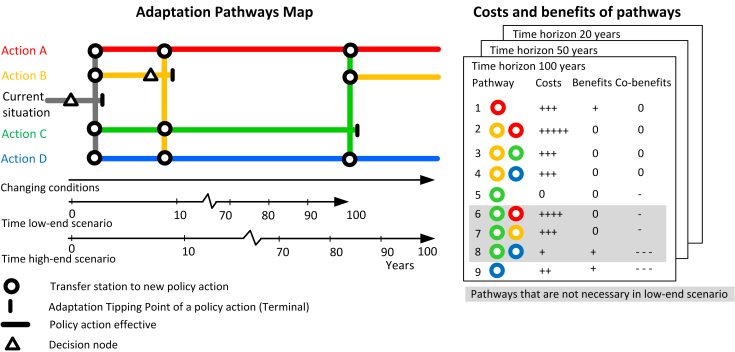Dynamic Adaptive Policy Pathways
Adaptation to the effects of climate change is becoming increasingly important. Adaptation is highly uncertain, in part due to uncertainties in emissions and projected warming, but also due to uncertainty in the range of potential impacts (e.g. sea-level rise). Despite this, most decisions in adaptation need to take place with appropriate recognition of uncertainties over long timescales (i.e. > 50 years). Making sound near-term decisions is crucial. Adaptation pathways serve as both a method and useful tool to overcome uncertainty and assist planners in long-term adaptation.
The Dynamic Adaptive Policy Pathways (DAPP) approach aims to support the development of an adaptive plan that is capable of dealing with conditions of deep uncertainty. The approach is developed by Deltares and TU Delft. It has inspired the Adaptive Delta Management concept of the Dutch Delta Programme, and is an emerging approach for adaptation decision making worldwide.
An adaptive plan specifies actions to be taken immediately to be prepared for near futures as well as actions to be taken to keep options to adapt open in more distant futures if needed. The exploration of adaptation pathways is one of the main ingredients of an adaptive plan. A monitoring system collects information to receive early warning signals for implementation of actions or for reassessment of the plan. The figure illustrates the DAPP approach.

What are Adaptation Tipping points?
Adaptation Tipping Points (ATP) are a key concept in DAPP. An adaptation tipping point specifies the conditions under which the status quo, a policy action or a portfolio of actions will fail. An adaptation tipping point is reached when the magnitude of external change is such that a policy no longer can meet its objectives, and new actions are needed to achieve the objectives. The timing of an adaptation tipping point (the sell-by year of actions) is scenario dependent. More information on the ATP’s is given below.
Beginning with DAPP policy analysis
DAPP policy analysis begins with the identification of the objectives, constraints, and uncertainties that are relevant for decision-making. The uncertainties are then used to generate an ensemble of plausible futures. These futures are compared with the objectives to see if problems arise or if opportunities occur. This determines if and when any adaptation thresholds or limits may occur and thus when adaptation is needed.
Next, the adaptation ‘solution space’ is mapped including adaptation options and their associated thresholds, limits and opportunities. Promising options are used as the basic building blocks for the assembly of potential adaptation pathways (a sequence of measures or portfolio of measures), that can be presented in an adaptation (pathways) map. A scorecard presents the costs and (co)-benefits of each of the pathways. The figure below gives an example of such an adaptation map and scorecard.
From this analysis, near-term action and long-term options are identified to be included as part of an adaptive plan. The plan is complemented by indicators to monitor and derive signals about progress and changing conditions that may demand further adaptation. It is also elaborated with additional actions to foster a successful enabling environment to support implementation of the adaptation pathways.
DAPP enables initial decisions to be made that do not lock in investments, thus leaving flexibility to change path and avoid maladaptation. By doing so, it enables adaptation to start, rather than waiting for ‘certainty’ which will always come too late or perhaps never at all.
What are Adaptation Pathways?
Adaptation pathways describe a sequence of measures or investments in institutions and infrastructure over time to achieve a set of pre-specified objectives under uncertain changing conditions. An adaptation pathways map provides insight into policy options, the sequencing of actions over time, potential lock-ins, and path dependencies.

An adaptation pathways map shows different possible sequences of decisions to achieve objectives. A scorecard helps to evaluate the pathways and decisions. In this example, starting from the current situation, targets begin to be missed after four years; an adaptation tipping point is reached. Following the grey lines of the current plan, one can see that there are four options.
Actions A and D should be able to achieve the targets for the next 100 years in all scenarios. If Action B is chosen, an adaptation threshold (or tipping point) is reached within about five more years; a shift to one of the other three actions (A, C, or D) will then be needed to achieve the targets. If Action C is chosen after the first four years, a shift to Action A, B, or D will be needed after approximately 85 years in the high-end scenario (follow the solid green lines).
In all other scenarios, the targets will be achieved for the next 100 years (the dashed green line). The colors in the scorecard refer to the actions: A (red), B (orange), C (green), and D (blue). The point at which the paths start to diverge can be considered as a decision point. Considering lead time, e.g. for implementation of actions, this point lies before an adaptation threshold.
Adapting a plan with adaptation thresholds and opportunities
The concept of adaptation thresholds (also referred to as Adaptation Tipping Points) emerged in response to a desire among Dutch policymakers to make it easier to update plans in light of new climate scenarios. It is a so-called vulnerability/bottom-up approach.
An adaptation tipping point is reached when the magnitude of external change is such that a policy no longer can meet its objectives. The timing of this point (the sell-by year of actions) is scenario dependent. This way a plan can be easily adapted in case of new information on changing conditions such as new (climate) scenarios; in which case only the timing of actions needs to be adapted.
The concept also helps to stress-test current strategies and identify when new (transformational) adaptation is needed.
You have not yet indicated whether you want to accept or reject cookies. This means that this element cannot be displayed.
Or go directly to:
DAPP in practice
Pathways design typically follows a staged and iterative approach wherein pathways are explored, screened, and further elaborated and selected. This follows different levels of analysis, from a qualitative assessment based on narratives, to a more comprehensive model-based assessment, all with stakeholder involvement. Deltares uses serious gaming for awareness raising. The pathways generator can assist in designing the pathways.
Projects and applications
DAPP has been applied worldwide. Its initial application in the Netherlands formed part of the Dutch Delta Programme’s adaptive delta management approach, aiding in the formulation of flood risk and freshwater availability strategies into the future. It has since assisted with the exploration of long-term adaptation strategies for extreme sea level rise in the Netherlands, among many other applications.
Elsewhere, Deltares has applied DAPP in a variety of contexts and problem domains, including flood risk management, water utility planning, road infrastructure planning, and climate resilient development. A selection of these applications includes:
- Adaptive flood risk mitigation strategies in the United States, e.g. for Miami Dade County (Florida) and Calcasieu Parish (Louisiana)
- Adaptive flood risk management for Danish municipalities
- Adaptive strategies for water utility infrastructure upgrades in Australia, though our ongoing partnership with local consultant Aurecon
- Climate resilient investment pathways to support sustainable WASH servicing, economic development and disaster resilience for ports and settlement infrastructure for cities Noro & Munda in the Solomon Islands
- Adaptive road planning in the Philippines, Dominican Republic, and Kazakhstan
The approach is presently being widely applied within several of Horizon Europe’s Mission Adaptation projects, including:
- Pathways2Resilience, supporting the development of transformational adaptation strategies across European regions and is incorporated as part of this project’s Regional Resilience Journey
- NBRACER, demonstrating how to mainstream Nature Based Solutions for climate resilient transformations across Europe
- DesirMED, demonstrating how to mainstream Nature Based Solutions for climate resilient transformations in the Mediterranean
- MIRACA, developing a research-based toolkit to prepare Europe’s critical infrastructure to withstand extreme weather events.
Several guidance documents on the approach have also been developed. A selection includes:


